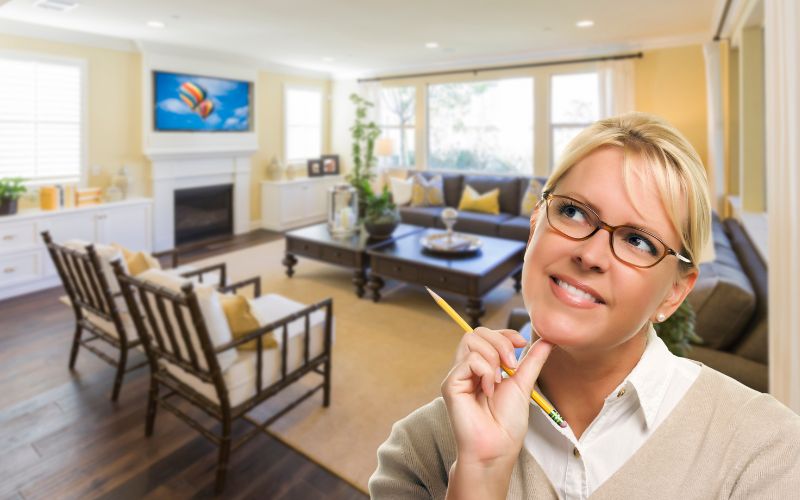
When a REALTOR ® mentions staging your home, they’re talking about the process of getting a house ready for the market. Staging a home is intended to highlight its best features, excite potential buyers, and sell it promptly for the highest price.
Although often confused, home staging and home decorating are similar but different. They have different objectives; Decorating is about putting a personal style fingerprint on a home, while staging makes your home appealing to the largest pool of buyers.
A key principle of home staging is in making it appealing while removing the personal fingerprint mentioned above from the home. You’ll have an advantage if you decide to stage your house because not many investors do, especially those selling or renting homes in lower price ranges.
Statistically speaking, staged homes sell for 1-5% higher, or more. REALTORS ® report that they have watched identical condos listed at the same time sell tens of thousands of dollars apart, with the only difference being staging.
Relative to the amount of expense and time output, staging may be one of the most lucrative projects you ever embark upon.
Potential buyers and renters aren’t just looking for a building to live in—they’re also looking for a way to fulfill their dreams and enhance their lifestyle and that of their family.
Staging can draw upon the heartstrings of a buyer or renter making for a more emotional purchase for the buyer, which ultimately can generate more money for the seller.
Some real estate salespeople do the staging themselves and others bring in a home staging professional to do it on the owner’s behalf.
One suggestion that we at Canadian Real Estate Wealth have for you is to confirm which party will absorb the cost of the home staging services if an independent contractor is used. Will it be the real estate agent or the homeowner?
Home staging costs can vary greatly depending on the square footage of the property, how long the staging products will be in the home and whether the entire property is being staged or just a selection of rooms in the house.
Be prepared to pay for things like painting, storage organizers, furniture and rental furnishings, floral arrangements, and cleaning supplies.
Some people are mistakenly under the impression that selling a house empty is better since potential buyers can better envision their belongings and furnishings in the space and use the blank template to let their imaginations run. Additionally, you would save on the costs to stage.
Still, industry reports consistently show time and time again that staged homes do often sell faster.
The staging process, whether through a REALTOR ® or a hired service provider usually begins with a consultation. This is when the staging person will walk through the property, making notes, taking measurements, and snapping photos.
What comes out of this consultation is two-fold; the stager will devise a plan for the work that they do, but it’s also quite common for them to have a list of recommendations for the property owner to do, as well.
Be prepared to pay for things like painting, storage organizers, furniture and rental furnishings, floral arrangements, and cleaning supplies.
The time that it takes to stage a home can vary greatly, as well.
It depends on the level of staging and the size of the home, but usually, it takes between 5-10 hours. This window of time is above and beyond the time spent decluttering, cleaning, and planning. Large or vacant homes can take 2-3 days to stage completely.
Yes, you can stage a home entirely, but home staging services can also be used piecemeal to focus on the rooms in which potential buyers spend the most time. If you do choose a partial staging, we recommend that you focus your energies on the kitchen, living room, front entrance, and primary bedroom.
New trends have homeowners opting for do-it-yourself home staging (as opposed to hiring a professional stager). Staging remains an important tool because a well-staged home looks better in photographs—and most potential buyers and renters being their journey for their next big chapter by looking for homes online.
De-cluttering, cleaning, or replacing your appliances to make them look brand-new, removing any sentimental items like photos and monogrammed towels, and getting rid of odours are a few home staging suggestions.

Here are a few more suggestions that may prove useful in enhancing your investment property value through staging:
- Clean! A clean home shows potential buyers and renters that you’ve taken good care of your investment property. As daunting as it sounds, you should clean every inch of the house, from the floors to the ceilings—and everything in between. If you don’t have the capacity to clean every nook and cranny, many local companies would be all too happy to do so for you.
- Replace Appliances. If this is not in the budget, ensure that those appliances are spic and span. In fact, they should be so clean that you could, well, eat off of them.
- Immaculate bathrooms, or lack thereof, can make or break a home sale or a rental opportunity. Make sure your bathroom sparkles; from the sink drain to the corners of the bathtub to that spot behind the toilet that you don’t think anyone can see. Your goal should be to make everything look brand new.
- Declutter! There are two major problems with clutter: (i) It distracts buyers from your home’s features. (ii) It makes it seem like the home has less space
Should you Stage a Rental?
You’ve put in all the effort necessary to locate and purchase a rental property. You’ve perused every listing, submitted every offer, and at last completed the closing. There is just one more item you need before your brand-new investment can start paying you money for years to come—a good-quality tenant!
One of the seemingly endless challenges of being a landlord is finding good tenants, but there are certain crucial actions you can take to boost your chances of doing so.
A fantastic method to show tenants that you’re a dedicated landlord and to give them the chance to envision themselves living there and projecting their aspirations onto it is to take your time when preparing rental homes.
Additionally, well-presented rental properties make for more appealing property photographs, drawing potential tenants to your investment home when they begin their search online.

In Conclusion,
Good staging is “a form of visual merchandising that draws on some of the fundamentals of interior design,” says Gordon Roberts, a broker with Sotheby’s International Realty. “The object of staging is to flatter the property but not be too obvious about it, like being dressed without drawing particular attention to what you’re wearing.”






